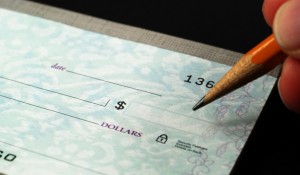How to Connect Your Bank Account to Quickbooks
 Quickbooks allows users to connect their bank account(s) in just a few easy steps. What’s the purpose of doing this you ask? Well, with your bank account connected to Quickbooks, you can automatically download a list of all of your transactions. Instead of manually entering each and every transaction into Quickbooks, for instance, you can simply download the transactions from your bank account. Today we’re going to walk you through the process of connecting a bank account to Quickbooks.
Quickbooks allows users to connect their bank account(s) in just a few easy steps. What’s the purpose of doing this you ask? Well, with your bank account connected to Quickbooks, you can automatically download a list of all of your transactions. Instead of manually entering each and every transaction into Quickbooks, for instance, you can simply download the transactions from your bank account. Today we’re going to walk you through the process of connecting a bank account to Quickbooks.
To connect a bank account to Quickbooks, fire up your Quickbooks software and choose “Connect an Account” under the “Bank Accounts” menu on the Homepage. You will then see a new screen asking you for information associated with your bank account. Don’t worry, it’s completely safe and secure to enter your banking information in Quickbooks. In the “Import transactions from your bank or credit card” field, enter the URL of your online banking account. To the right of this field, you’ll need to enter the username and password associated with this account.
Assuming you entered the correct login URL, username and password for your online banking account, Quickbooks will reveal a list all of the accounts associated with the bank. If you only have a single account, you’ll see a single account listed. But if you have several banking accounts, you will see all of them listed. Select the account that you wish to use in conjunction with Quickbooks and specify whether it is a checking, savings, money market, credit card, or trust account.
Once connected, you will see all of the accounts you have at this bank. Choose the account you use for your business and tell QuickBooks what kind of accounts they are. Quickbooks will then pull all of the transactions that were made from the account within the past 90 days.
On the next page, click Category or Match column to begin sorting the transactions made from the past 90 days. If you wish to place a transaction in a separate window, you can do so by opening the transaction menu and selecting the appropriate one. For new transactions, simply click “Add” on the right-side of the page to add the new transaction.
Did this tutorial work for you? Let us know in the comments section below!
How to Print Pay Stubs in Quickbooks (the Easy Way)
 Looking to print pay stubs from your Quickbooks account? There’s actually a quick and way to do this. All it takes is a few basic steps which we’re going to reveal in today’s blog post.
Looking to print pay stubs from your Quickbooks account? There’s actually a quick and way to do this. All it takes is a few basic steps which we’re going to reveal in today’s blog post.
To print pay stubs, log into your Quickbooks account and select File > Print Forms > Pay Stubs. This should reveal all of the pay stubs/checks associated with your account. If you want to print a pay stub that’s attached to a separate payroll account, you’ll need to select the account from the “Bank Account” menu. Just click the drown-down menu and select the appropriate account. Quickbooks will reveal all of the checks from that payroll account along with their respective dates.
Depending on the size of your Quickbooks account, you may have trouble locating a single pay stub. In this case, you should narrow the results down by using a custom date range. In the “Checks Dated and Thru” fields, enter a date range during which you believe the payment was made. You can also narrow down your selection by clicking the “Employee” drop-down menu and selecting the employee to whom the payment was sent.
Once you’ve selected the appropriate payment, click the “Print” button. Although optional, you can also specify a different font and/or printer here. If you want to use a font that’s common used throughout your business’s marketing material, for instance, you can do so from the options here. Before the pay stub(s) begin to print, you must specify the number of copies you wish to create. When you are finished, click “Print” once again to begin printing your pay stub.
Keep in mind that when you print a pay stub on blank paper, your company’s name, street address and phone number will be listed twice. This information will be located both at the top of the page and at the bottom.
Alternatively, you can choose to email pay stubs to your employees from within the Quickbooks interface. Some people avoid this option, assuming it’s a security risk. But all emailed pay stubs are password-protected in PDF format, preventing unauthorized users from opening or accessing them.
Did this tutorial work for you? Let us know in the comments section below!
Quickbooks Tutorial: How to Merge Multiple Accounts
 Looking to merge multiple Quickbooks accounts into a single account? If you are reading this, I’m assuming the answer is yes. It’s not uncommon for accountants to set up several Quickbooks accounts, using one for each business for whom they provide services. While this may seem like the best solution, there’s really no need to use multiple accounts, as it only created greater confusion. Thankfully, you can merge multiple accounts together in just a few easy steps.
Looking to merge multiple Quickbooks accounts into a single account? If you are reading this, I’m assuming the answer is yes. It’s not uncommon for accountants to set up several Quickbooks accounts, using one for each business for whom they provide services. While this may seem like the best solution, there’s really no need to use multiple accounts, as it only created greater confusion. Thankfully, you can merge multiple accounts together in just a few easy steps.
Warning
Keep in mind that you cannot “undo” the changes after merging two accounts together. It’s a permanent process, so make sure you are comfortable with the process before proceeding. All transactions from BOTH accounts will be merged together, which may affect closed transactions as well as financial reports.
Furthermore, there are certain occasions in which you cannot merge two accounts together. This includes the merging of three or more accounts (you can only merge two). And you only merge accounts of the same type. If the accounts are of different types, you will not be able to merge them together.
Merging Your Accounts
When you are ready to begin, log into your Quickbooks account and select the Lists menu > Chart of Accounts. Verify that the accounts you wish to merge are located on the same level on the list. If they are on different levels, you must move them to the same. Next, click the account that you wish to eliminate (don’t worry, it will be merged). Now click the “Account” link at the bottom followed by “Edit Account.” From here you can rename the account to match the account that you are merging. When you are finished, click Save & Close to complete the process. Sorry if you were expecting more, but that’s all it takes to merge two Quickbooks accounts together!
Hopefully, this will give you a better idea of how to merge two Quickbooks accounts together. It’s a relatively quick and easy process that most people can do themselves, without the need for technical assistance. Assuming you have a Hosted Quickbooks plan, though, you can always seek help if needed.
Did this tutorial work for you? Let us know in the comments section below!
Quickbooks Tips and Tricks for Accountants
 Choosing the Right Version of Quickbooks
Choosing the Right Version of Quickbooks
Many people are surprised to learn that there are several types of Quickbooks, each of which has its own unique features and characteristics. The three different types include Quickbooks Online, Desktop Quickbooks, and Hosted Quickbooks. So, which one should you choose? Hosted Quickbooks is actually the Desktop version that’s “hosted” by an authorized third-party. It offers the greatest flexibility and easy of use, making it the recommended choice for accountants.
Close Windows Fast
There are two different ways to close windows in Quickbooks: you can close them by clicking the [x] button in the upper-right corner, or you can do it simply by pressing the Esc key. If you are trying to streamline your accounting (which you should be), try to get into the habit of using the Esc key. This alone can save you huge amounts of time, as it eliminates the need to move your mouse around from window to window.
Disable Spellcheck
Quickbooks has a built-in spellcheck that’s enabled by default. This feature is great for catching those grammar and spelling mistakes in your invoices and other documents. However, it can also be a nuisance, especially when it catches words that aren’t really mispelled. You can disable the spellcheck feature by logging into your account and choosing Edit > Preferences > My Preferences > and untick the box next to “Always check spelling before printing … .”
There’s a Hidden Calculator…
Did you know that Quickbooks has a calculator built into never field? Rather than opening a separate calculator on your computer, you can simply crunch your numbers straight from the field. To use it, click on a field and then press the + button. This will enable the calculator so you can add, subtract and perform other operations.
Templates
Another helpful feature included in Quickbooks is pre-made templates. Whether you are a contractor, accountant, business owner, etc., there’s probably an invoice template for you. But you don’t have to limit yourself to only using the invoice templates provided in Quickbooks. All of these templates can be edited and customized according to your liking.
How to Use a Custom Invoice Template in Quicbooks
 Want to send your customers or client a custom invoice template? If you are reading this, I’m assuming the answer is yes. Custom templates are a great way to enhance your brand’s image, presenting your business in a more professional manner. Thankfully, Quickbooks offers a quick and easy solution for business owners and accounts who wish to use custom templates. Here’s how.
Want to send your customers or client a custom invoice template? If you are reading this, I’m assuming the answer is yes. Custom templates are a great way to enhance your brand’s image, presenting your business in a more professional manner. Thankfully, Quickbooks offers a quick and easy solution for business owners and accounts who wish to use custom templates. Here’s how.
To create a custom invoice template, log into your Quickbooks account, and from the main menu, select Customers > Create Invoices. You should now a see of list of pre-made templates offered by Quickbooks. Scroll through the list and choose the one that you would like to customize. You can click the “Print Preview” button at the top right of the template to preview how it will look once printed.
Quickbooks offers several different pre-made templates by default, each of which can be customized according to your liking. Some of these templates includes invoices for accountants, invoices for contractors, invoices for franchises, invoices for nonprofits, invoices for retail businesses, invoices for service industries, and general invoice templates with varying graphics and colors.
After choosing a template, click “OK” to open the template so you can edit it. There are several different ways to customize an invoice template, some of which includes the following:
- Add your company’s logo to the the template (you can also move the logo around to different locations).
- Update the template to reflect your company’s contact information.
- Include terms and conditions on the template.
- Add or remote the “status stamp.”
- Edit the title of your invoice template.
- Rename any of the fields on the template, such as date, invoice number, and ship to.
- Include the customer or client’s balance on the template.
- Rename a column on the template.
- Add lines and/or borders on the template.
Once you are finished editing your invoice template, click “Save” to save the changes and close out of the template editor. You may then choose your new template when sending an invoice to a customer or client. Assuming you chose the appropriate template, it should reflect all of the changes that you recently made.
Intuit Using Wind Turbines to Power its Offices
 Quickbooks maker Intuit is reportedly using wind turbines to power its offices.
Quickbooks maker Intuit is reportedly using wind turbines to power its offices.
In a recent statement to the press, a spokesperson for Intuit said it was in the process of transitioning its Plano, Texas campus to wind power in an effort to curb greenhouse gas emissions and promote greater energy efficiency.
The Plano, Texas campus is one of the company’s largest facilities, with roughly 500 workers whom perform services for Intuit’s Accountant and Advisor Group — a branch that offers products and services designed that are tailored towards accountants. Because it’s one of the company’s largest facilities, it also uses a significant amount of energy, which is something that Intuit hopes to change by making the transition to wind turbines.
As of October 1, 2015, Intuit’s Plano, Texas campus is now powered 100% by wind energy. Wind energy is produced via turbines (see image above) that spin when exposed to wind. As the turbines spin, they create, and store, power that is then transferred through the power grid before ending up at Intuit’s campus.
So, what drove Intuit to transition its Plano, Texas campus to wind energy? According to the company’s senior sustainability program manager, nearly 40% of Intuit’s carbon footprint comes from electricity. Intuit had previous set a goal of achieving a reduced “absolute” carbon footprint by 20% by 2020. To help turn this vision into a reality, it transitioned its Plano, Texas facility from standard coal power to wind power.
“Electricity usage accounts for almost 40 percent of Intuit’s overall carbon footprint,” said Sean Kinghorn, Intuit’s senior sustainability program manager. “We have set a goal of reducing our absolute carbon footprint by 20 percent by 2020 with a baseline year of 2012. RPD’s ability to creatively supply our Texas campus with 100 percent clean power will significantly reduce our company’s carbon footprint and is one of several steps that we are taking to increase our use of on-site and off-site renewable energy.”
Of course, this is just one step Intuit has taken towards achieving its goal of a reduced carbon footprint. It’s safe to assume that the popular software maker will continue to emphasize the importance of clean, renewable energy in the months to come. Who knows, we may see other companies follow in Intuit’s footsteps by implementing energy-efficient practices of their own?
Can I Reprint Multiple Checks in Quickbooks?
 There’s a reason why Quickbooks is the world’s #1 accounting software for small businesses: because it’s versatile and easy enough for anyone to use, regardless of whether or not you have professional accounting experience. But many users wonder if there’s an option to print multiple checks within Quickbooks. There IS an option to print multiple checks, although it’s somewhat hidden. If you are struggling to print multiple checks within Quickbooks, keep reading for a step-by-step walkthrough.
There’s a reason why Quickbooks is the world’s #1 accounting software for small businesses: because it’s versatile and easy enough for anyone to use, regardless of whether or not you have professional accounting experience. But many users wonder if there’s an option to print multiple checks within Quickbooks. There IS an option to print multiple checks, although it’s somewhat hidden. If you are struggling to print multiple checks within Quickbooks, keep reading for a step-by-step walkthrough.
To reprint multiple checks, fire up your Quickbooks software and access the Banking menu at the top of the screen. This is your “go-to” menu for all banking-related tasks. Whether you need to print a single check or several, tasks such as these are typically done from the Banking menu. After accessing the Baking menu, choose “Use Register,” at which point you should see a drop-down menu with all of your bank accounts listed. Scroll through the list and choose the bank account associated with the check that you wish to reprint. Click “OK” to pull you the register for the selected bank account.
With the bank account register viewable, find and select the check that you wish to reprint. We’ve talked about this before on the MyVao.com blog, but it’s worth mentioning again that pressing the letter “T” will change the number of a check to “Print.” So if you haven’t done so already, go ahead and press “T” on your keyboard after selecting the appropriate check.
Next, click the “Record” option at the bottom right corner of the register, followed by “Yes” when prompted to record the changes. Assuming you followed the steps mentioned above, the check should now be visible in the “Print Queue.” You may then access File > Print Forms > Print Checks > choose the checks and click “OK.” Lastly, verify it’s the correct check and the printer and click “Print. Sorry if you were expecting more, but that’s all it takes to print multiple check in Quickbooks!
Of course, you can reprint single checks in just a few easy steps as well. This is done by accessing Banking > Write Checks > click the “Find” button > search for the check that you wish to reprint > double-click the check > and click “Print.
Did this tutorial work for you? Let us know in the comments section below!
Intuit and OnDeck Launch $100 Million Lending Fund
 Quickbooks maker Intuit has teamed up OnDeck to launch a $100 million lending fund for small businesses.
Quickbooks maker Intuit has teamed up OnDeck to launch a $100 million lending fund for small businesses.
According to the U.S. Small Business Administration (SBA), there are approximately 27.9 million small businesses operating in the U.S. Unfortunately, though, many of these startups struggle to succeed to due to a lack of funding. Without capital, small business owners will have an uphill battle as they try to stay afloat. But Intuit and OnDeck is hoping to make the process a little easier for small business owners by setting up a $100 million lending fund.
The new lending fund will allow small businesses to use the Quickbooks Online accounting platform to apply for loans. So instead of venturing out to various banks in an attempt to find the best loan at the lowest rate, small business owners can simply apply for loans through their Quickbooks Line account. It’s as easy as a few clicks of the mouse, which is sure to attract some small business owners to the platform.
Known as the Financing Line of Credit, the new fund will be ran by Intuit’s customer data while OnDeck’s technology will help power it. The two companies say the lending fund will offer improves financing options for small business owners with established credit.
Here’s a short list of some of the features of Intuit and Ondeck’s new Financing Line of Credit:
- Low interest rates, APRs ranging from just 8.9% to 19.9%
- Small business owners may obtain funds just one day after their application has been approved, allowing them to focus on other aspects of running and growing their business.
- Applications for Financing Line of Credit are simple and straightforward.
“This new product is all about empowering small businesses to leverage the power of their own data so that they can take advantage of better financing options. Small businesses rely on financing to power their growth, to invest in new employees, new equipment, and new opportunities,” said Dan Wernikoff, executive vice president and general manager of Intuit’s Small Business Group “We’re excited to continue working with OnDeck to fuel more small business success.”
What do you think of Intuit’s new Financing Line of Credit?
